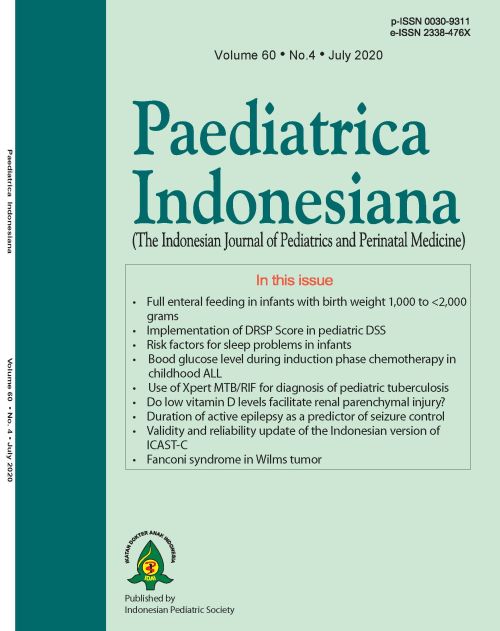Implementation of Dengue Recurrent Shock Prediction Score in pediatric dengue shock syndrome
DOI:
https://doi.org/10.14238/pi60.4.2020.178-85Keywords:
dengue shock syndrome; recurrent shock; DRSPSAbstract
Background Global morbidities due to dengue viral infection increase yearly. The pediatric mortality rate from dengue shock syndrome (DSS) remains high. Early identification of the risk of recurrent shock may serve to increase awareness and reduce mortality. The Dengue Recurrent Shock Prediction Score (DRSPS) is a tool to predict recurrent shock in children with DSS, but the optimal cut-off point in our population is still unknown.
Objective To assess the validity of the DRSPS by determining the optimal cut-off point that can be used in Indonesia
Methods This cross-sectional prospective study was done at Sanglah Hospital, Denpasar, Bali, from January 2019. Risk of reccurent shock were classify based on DRSPS in all DSS patient, and they were observed whether they will experienced recurrent shock or not.
Results Of 56 children with DSS, 27 subjects had recurrent shock and 29 subjects did not. The optimal DRSPS cut-off point was -189.9 for predicting recurrent shock, with 87.4% area under the curve (AUC), 81.5% sensitivity and 82.8% specificity.
Conclusion The optimal cut-off point of DRSPS was -189.9 and it has good validity. The results of this study are expected not only to be used as the basis for further study, but to increase physician awareness in treating DSS patients.
References
Junia J, Garna H, Setiabudi D. Clinical risk factors for dengue shock syndrome in children. Paediatrica Indonesiana. 2007;47:7-11. DOI: 10.14238/pi47.1.2007.7-11.
Tarigan AD, Gustawan IW, Utama IMD. Risk factors of recurrent shock in children with dengue shock syndrome. Poster presented at: Excellence in clinical practice. 11th International Congress of Tropical Pediatrics; 2017 Aug 4-7; Yogyakarta.
Huy NT, Thao NT, Ha TT, Lan NT, Nga PT, Thuy TT, et al. Development of clinical decision rules to predict recurrent shock in dengue. Crit Care. 2013;17:1-8. DOI: 10.1186/cc13135.
Raihan, Hadinegoro SRS, Tumbelaka AR. Faktor prognosis terjadinya syok pada demam berdarah dengue. Sari Pediatri. 2010;12:47-52. DOI: 10.14238/sp12.1.2010.47-52.
Lam PK, Tam DT, Dung NM, Tien NT, Kieu NT, Simmons C, et al. A prognostic model for development of profound shock among children presenting with dengue shock syndrome. PLoS One. 2015;10:1-13. DOI: 10.1371/journal.pone.0126134.
World Health Organization. Comprehensive guidelines for preventions and control of dengue and dengue hemorrhagic fever. Revised and expanded edition. New Delhi: WHO Regional Office for Southeast Asia; 2011.
Tatura SNN, Kalensang P, Mandei JM, Wahyuni S, Yusuf I, Daud D. Albumin level as a predictor of shock and recurrent shock in children with dengue hemorrhagic fever. Crit Care Shock. 2017;20:24-29. Downloaded from: http://criticalcareshock.org/2017/05/albumin-level-predictor-shock-recurrent-shock-children-dengue-hemorrhagic-fever/albumin-level-as-a-predictor-of-shock-and-recurrent-shock-in-children-with-dengue-hemorrhagic-fever/
Halstead SB. Dengue fever and dengue hemorrhagic fever. In: Kliegman RM, Stanton BF, St. Geme JW, Schor FN, Behrman RE, editors. Nelson textbook of pediatrics. 20th ed. Philadelphia: WB Saunders; 2016. p. 1147-50.
Ebi KL, Nealon J. Dengue in a changing climate. Environ Res. 2016;151:115-23. DOI: 10.1016/j.envres.2016.07.026.
Md-Sani SS, Md-Noor J, Han WH, Gan SP, Rani NS, Tan HL, et al. Prediction of mortality in severe dengue cases. BMC Infect Dis. 2018;18:232. DOI:10.1186/s12879-018-3141-6
Sastroasmoro S, Ismael S. Dasar-dasar metodologi penelitian klinis. 5th ed. Jakarta: CV Sagung Seto; 2014. p. 219-43.
Megawati D, Masyeni S, Yohan B, Lestarini A, Hayati RF, Meutiawati F, et al. Dengue in Bali: clinical characteristics and genetic diversity of circulating dengue viruses. PloS Negl Trop Dis. 2017;11:e0005483. DOI: 10.1371/journal.pntd.0005483.
Downloads
Published
How to Cite
Issue
Section
License
Authors who publish with this journal agree to the following terms:
Authors retain copyright and grant the journal right of first publication with the work simultaneously licensed under a Creative Commons Attribution License that allows others to share the work with an acknowledgement of the work's authorship and initial publication in this journal.
Authors are able to enter into separate, additional contractual arrangements for the non-exclusive distribution of the journal's published version of the work (e.g., post it to an institutional repository or publish it in a book), with an acknowledgement of its initial publication in this journal.
Accepted 2020-07-07
Published 2020-07-07


















